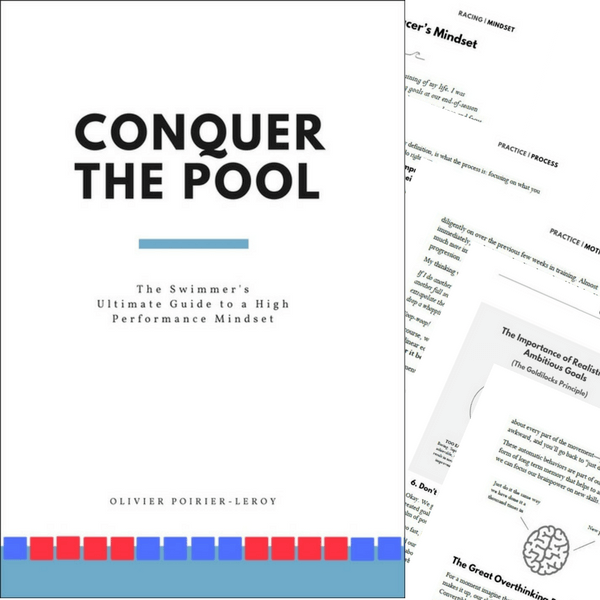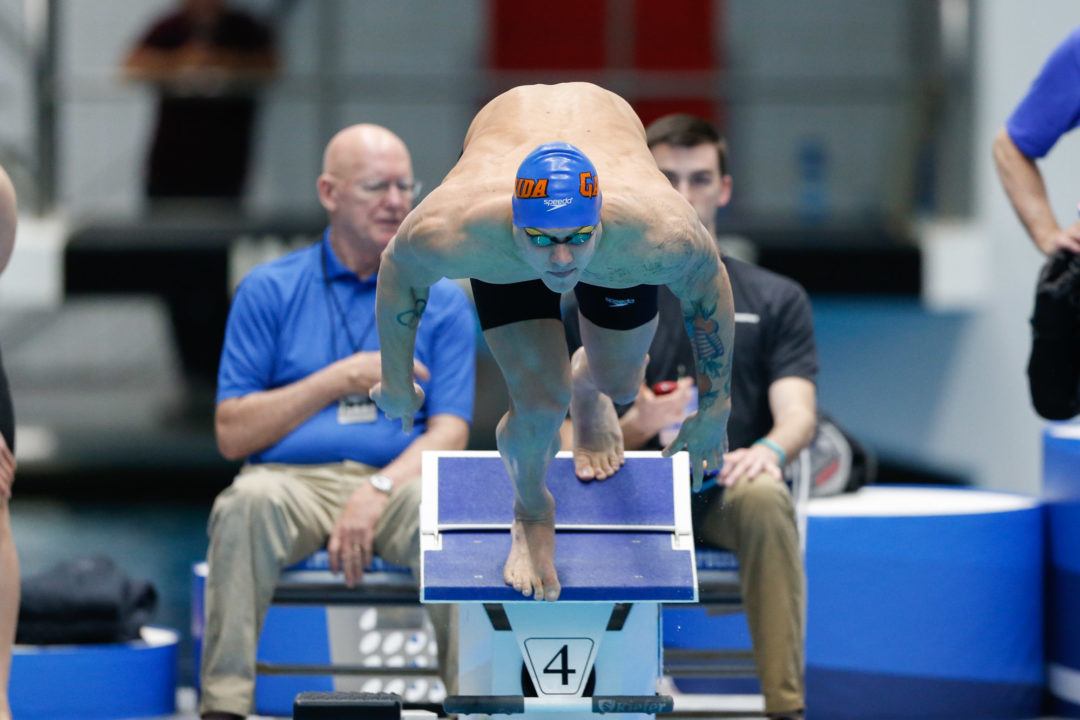by Olivier Poirier-Leroy. Join his weekly motivational newsletter for competitive swimmers by clicking here.
The block. The start. The dive.
It’s the first thing we do in competition, and yet, it’s often the thing we spend the least amount of time on in swim practice.
Although once in a while we will do a few starts after practice, or coach will have us dive through a hula hoop (for a clean entry) or use a pool noodle as a marker for distance, for many swimmers, it’s an after-thought.
Which is too bad.
Swimmers like Caeleb Dressel, who could make a good case for having the best start in the world right now, understand the value of refining and improving their swim start.
A faster, more explosive start can throw you out to an early lead, demoralize the competition, and of course, power you to faster times. All the wins.
How to Get More Distance Off the Blocks
Having a fast start is more than just being able to react quickly to the starter’s gun.
As Dressel showed at the 2017 FINA World Championships, having the fastest reaction time isn’t necessary to dominating the competition—it’s the height, distance, velocity and angle of entry that affect how much speed you carry into the water and through the breakout.
Vertical jump training—squat jumps, jumping up onto a plyometric box, and so on—are pillars of the dryland programs for most swimmers. And with good reason: improving your vertical gives you a greater ability to improve start performance (and this has been reflected in a couple different studies, here and here).
But vertical jump training ignores one important aspect that is critical to improving the swim start: we need to be able to achieve horizontal velocity too.
The Study: Long Jumping for Better Swim Start Performance
Researchers [1] took a group of 10 competitive swimmers and had them undergo a 9-week plyometric program that focused on long jumping. During the twoish months that followed, our test group didn’t do any supplemental start training.
The training was straight-forward: For the first couple weeks the swimmers did 8×2 horizontal long jumps twice a week. For the remainder of the program, they did 15×2, with a rest period of two minutes between each set. The long jumps were performed off a platform that was constructed at the same angle of a starting block.
The results?
There was a 7% increase in the swimmer’s’ ability to produce horizontal force (helping you get farther off away from the blocks) and a 16% increase in horizontal velocity (helping you get into the water with more speed).
This is a crazy amount of improvement in power and speed, especially when you consider the relatively small amount of training time involved in making these gains happen.
Because of the specificity of the movement—the long jump more closely replicates a swim start than a straight vertical jump—the researchers surmise that this type of training is far more effective than the more traditional performed vertical jump training.
Faster starts, with a minimal amount of time? Giddyup.
ABOUT OLIVIER POIRIER-LEROY
Olivier Poirier-Leroy is a former national level swimmer. He’s the publisher of YourSwimBook, a ten-month log book for competitive swimmers.
 He’s also the author of the recently published mental training workbook for competitive swimmers, Conquer the Pool: The Swimmer’s Ultimate Guide to a High Performance Mindset.
He’s also the author of the recently published mental training workbook for competitive swimmers, Conquer the Pool: The Swimmer’s Ultimate Guide to a High Performance Mindset.
It combines sport psychology research, worksheets, and anecdotes and examples of Olympians past and present to give swimmers everything they need to conquer the mental side of the sport.
Ready to take your mindset to the next level?
Click here to learn more about Conquer the Pool.
COACHES: Yuppers–we do team orders of “Conquer the Pool” which include a team discount as well as complimentary branding (your club logo on the cover of the book) at no additional charge.
Want more details? Click here for a free estimate on a team order of CTP.

A big difference is that on land they won’t need to keep climbing out of the pool, each time a jump is performed. There must be a better way than doing a long jump though, like diving onto a crash mat. At least that would mimic most of a dive.
Did the research mention how and if the 7% and 16% increases transferred into the actual improvement in acquired skills in swim starts?
Completely agree with you – and also test and train single leg jumps to measure leg deficiencies.
Senior-level and advanced level Swim Coaches and S&C coaches can cater to their individualized athletes’ performance goals and needs by designing their exercise training programs based on force-velocity profiling. The competitive swim start requires the ability of the athlete to rapidly produce force in order to initiate bodily movement off the blocks to start a race. Force-Velocity Profiling can be measured with a smartphone app using the video analysis of 3 or 4 loaded squat jumps to be performed by the athlete (bodyweight + graded percentage of bodyweight increases as load/intensity on barbell), with athlete height, and limb length also taken into equation to determine FV ratio. The FV ratio gives the practitioner a diagnostic tool to determine whether the… Read more »
The French have done unpublished research on a similar concept. As seen in the link below.
http://jbmorinsportscience.blogspot.com/2016/08/optimal-fv-profile-in-sprint-swimmers.html?m=1
Some one is mad
LOL. “Competitive swimmers”. I guess I should just fill in the gaps. Swimmers between the ages of 4 and 4 competing at their Home Owners Association pool…
Since the article references specificity, let’s point out that hardly any swimmer uses a 2 foot forward grab start these days. Therefore, doing high jumps from a running start taking off from your track start lead foot is much better specificity of training than two foot standing long jumps from an angled box. Of course, no high jumpers use the straddle form anymore, so unless the swimmers want to enter the water back first, the fosbury flop must negate the specificity value I just claimed for high jumping!!
16% is a huge increase statistically. Think of how much swimmers practice in order to improve lifetime best times by just 1 or 2% in a race.
Certainly more than one study would need to be done. But the results seem to merit at least a further inquiry into the matter.
And of course swimmers should also being doing starts off of the blocks in practice. But assuming they are already doing that, as are their competitors, a way must be found to gain an edge.
Maybe it’s this, maybe not, but you can’t argue with the results.
Wow!! With that thinking, why do any sort of dryland? Why don’t we just stay in the pool?
Okay so obviously practicing your starts is how you will get better at them, but doing other small supplementary steps along the way can certainly help you with it. They didn’t do starts in this study in order to try to isolate the study group as far as they could. Working on long jumps, box jumps, etc. can CERTAINLY improve your start.
That’s exactly what MA does. Virtually no dryland up until very recently, and then just pullups and body weight stuff.
As a former competitive swimmer and now a full-time performance coach who spends most of my time working with high-performance athletes and studying every which way to increase their performance, I would say the following:
1a.) This article doesn’t outline the age, development or skill of the 10 swimmers. We know nothing about them and that tells the entire story of their “gains”. No doubt they exist but it doesn’t outline if they have ever done any type of plyometric, strength or explosive training prior to this test. Improvements can happen in ANY AREA that we apply time and attention to hence the SAID (specific adaptation to imposed demand) principle of training and performance. Where our energy goes, performance… Read more »